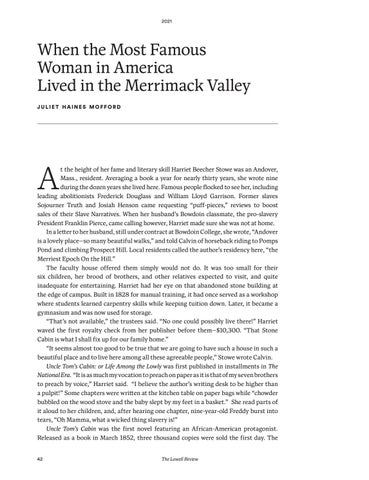2021
When the Most Famous Woman in America Lived in the Merrimack Valley juliet haines mofford
A
t the height of her fame and literary skill Harriet Beecher Stowe was an Andover, Mass., resident. Averaging a book a year for nearly thirty years, she wrote nine during the dozen years she lived here. Famous people flocked to see her, including leading abolitionists Frederick Douglass and William Lloyd Garrison. Former slaves Sojourner Truth and Josiah Henson came requesting “puff-pieces,” reviews to boost sales of their Slave Narratives. When her husband’s Bowdoin classmate, the pro-slavery President Franklin Pierce, came calling however, Harriet made sure she was not at home. In a letter to her husband, still under contract at Bowdoin College, she wrote, “Andover is a lovely place—so many beautiful walks,” and told Calvin of horseback riding to Pomps Pond and climbing Prospect Hill. Local residents called the author’s residency here, “the Merriest Epoch On the Hill.” The faculty house offered them simply would not do. It was too small for their six children, her brood of brothers, and other relatives expected to visit, and quite inadequate for entertaining. Harriet had her eye on that abandoned stone building at the edge of campus. Built in 1828 for manual training, it had once served as a workshop where students learned carpentry skills while keeping tuition down. Later, it became a gymnasium and was now used for storage. “That’s not available,” the trustees said. “No one could possibly live there!” Harriet waved the first royalty check from her publisher before them—$10,300. “That Stone Cabin is what I shall fix up for our family home.” “It seems almost too good to be true that we are going to have such a house in such a beautiful place and to live here among all these agreeable people,” Stowe wrote Calvin. Uncle Tom’s Cabin: or Life Among the Lowly was first published in installments in The National Era. “It is as much my vocation to preach on paper as it is that of my seven brothers to preach by voice,” Harriet said. “I believe the author’s writing desk to be higher than a pulpit!” Some chapters were written at the kitchen table on paper bags while “chowder bubbled on the wood stove and the baby slept by my feet in a basket.” She read parts of it aloud to her children, and, after hearing one chapter, nine-year-old Freddy burst into tears, “Oh Mamma, what a wicked thing slavery is!” Uncle Tom’s Cabin was the first novel featuring an African-American protagonist. Released as a book in March 1852, three thousand copies were sold the first day. The 42
The Lowell Review

